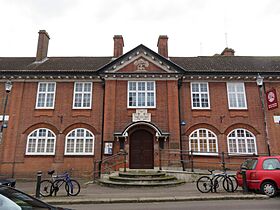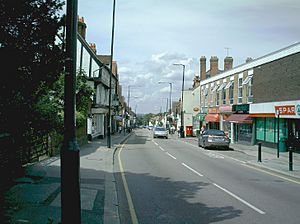Bushey facts for kids
Quick facts for kids Bushey |
|
|---|---|
 Bushey High Street in 2005 |
|
| Population | 28,416 (2021 census, built-up area) |
| OS grid reference | TQ132952 |
| District |
|
| Shire county | |
| Region | |
| Country | England |
| Sovereign state | United Kingdom |
| Post town | Bushey |
| Postcode district | WD23 |
| Dialling code | 020, 01923 |
| Police | Hertfordshire |
| Fire | Hertfordshire |
| Ambulance | East of England |
| EU Parliament | East of England |
| UK Parliament |
|
Bushey is a town in Hertfordshire, England. It is located in the East of England region. In 2021, about 28,416 people lived there. This makes Bushey the second largest town in the Hertsmere area.
Bushey Heath is a big neighbourhood in the south-east part of Bushey. It is close to the border with the London Borough of Harrow. This area is quite high up, reaching about 165 metres (541 feet) above sea level.
Contents
What's in a Name?
The name Bushey first appeared in a very old book called the Domesday Book in 1086. It was written as Bissei.
Experts believe the name comes from two old English words. These are bysc, meaning 'bush' or 'thicket', and hæg, meaning 'enclosure'. So, Bushey likely meant 'an area surrounded by bushes'.
Bushey's Past
The first official record of Bushey is from the Domesday Book in 1086. It described Bushey as a small farming village. Back then, it was called 'Bissei'.
But people lived in this area much earlier! Tools from the Stone Age have been found here. This shows that people were around during the Palaeolithic period.
Bushey also has links to the Romans. The main road through the town was built by Romans. Roman buildings and even a Roman floor made of small tiles have been found nearby.

Bushey Heath started to develop during the Napoleonic Wars. There was a big food shortage at that time. The government gave land to Bushey landowners to grow more food. This land was known as Bushey Common.
However, the area became popular for building homes. It was close to a railway and had great views.
The 19th and 20th centuries saw the biggest changes in Bushey. The number of people living there grew a lot. From 856 people in 1801, it grew to almost 24,000 today.
One main reason for this growth was the railway. It created many new jobs in nearby Watford. In the 1920s, the first council houses were built in Bushey. More homes were built for families working in defence jobs.
Eventually, the growth slowed down. This was because much of the land around Bushey became protected. It was part of the Metropolitan Green Belt after the Second World War. This law stopped a lot of new building.
The Green Belt also stopped a planned underground railway line. This line would have gone from Edgware to Bushey Heath. The railway was meant to help new homes be built. But with the Green Belt, new homes couldn't be built easily. So, the railway line was not finished.
The place where the Bushey Heath station would have been is now an industrial park. It's called Centennial Park Industrial Estate.
The highest point in the old county of Middlesex was in Bushey Heath. It was about 153 metres (502 feet) above sea level.
Old Stories and Legends
Bushey Heath used to be a very wooded area. There were no streetlights or police back then. This led to many stories about thieves and highwaymen.
According to one book, highwaymen would hide on the road from Bushey Heath to Stanmore. They would rob travellers carrying money from London. Before going through this area, groups of travellers would gather together. They would meet at inns like the Boot Inn in Edgware to travel safely in larger groups.
Some people say the famous highwayman Dick Turpin was active here. But evidence suggests he mostly operated in Essex.
How Bushey is Governed
Bushey has two main levels of local government. These are the Hertsmere Borough Council and Hertfordshire County Council. Bushey does not have its own separate town council. It has been an unparished area since 1974.
| Bushey | |
|---|---|
| Urban District | |
 Council offices, Rudolph Road, Bushey |
|
| Population | |
| • 1911 | 6,978 |
| • 1971 | 22,830 |
| History | |
| • Created | 1 April 1906 |
| • Abolished | 31 March 1974 |
| • Succeeded by | Hertsmere |
| • HQ | Council Offices, Rudolph Road, Bushey |
| Contained within | |
| • County Council | Hertfordshire |
For a long time, Bushey was a parish within a larger area called a hundred. In 1906, Bushey became its own urban district. This meant it had its own local council. The council built new offices and a fire station in 1909.
In 1974, the Bushey Urban District was changed. It became part of the new Hertsmere district. The old council offices are now the Bushey Museum & Art Gallery.
Bushey Today
Bushey hosts local events every year. These include the Bushey Festival and a quarter marathon race in July. There is also a flower and produce show by the Horticultural Society.
Bushey is near several film studios. Because of this, Bushey and Bushey Heath often appear in films and TV shows. For example, a bus scene in the Cannon and Ball film was shot here. The 1957 film Lucky Jim also featured Bushey.
Many historic buildings in Bushey have been used in movies. The old Royal Masonic School for Boys has appeared in films like Nuns on the Run and Children of Men. It was also used for scenes in Harry Potter films.
Several TV comedy shows have also filmed here. These include Monty Python's Flying Circus and Little Britain.
Warren Lake, a duck pond in Bushey Heath, was fixed up in 1992. It had fallen into disrepair before that.
Religions in Bushey
In 2021, the largest religious group in the Bushey Heath area was Jewish people.
The table below shows the different religions in Bushey in 2021:
| Area | All people | Christian (%) | Buddhist (%) | Hindu (%) | Jewish (%) | Muslim (%) | Sikh (%) | Other (%) | No religion (%) | Not stated (%) |
|---|---|---|---|---|---|---|---|---|---|---|
| England and Wales | 56,490,048 | 46.3 | 0.5 | 1.8 | 0.5 | 6.7 | 0.9 | 0.6 | 36.7 | 6.0 |
| Bushey | 28,416 | 37.44 | 0.55 | 7.69 | 19.68 | 4.25 | 0.39 | 1.20 | 22.43 | 6.36 |
Schools in Bushey
Bushey has many primary schools. Some are linked with infant and junior schools.
The main state secondary schools are Queens' School, Bushey Meads School, and The Grange Academy. Queens' School and Bushey Meads School usually perform well.
Bushey is also home to the famous Purcell School. This school is for talented young musicians. It is known for helping many successful musicians get their start.
There are also two private schools for girls in the area: St. Hilda's and St Margaret's.
Herkomer's Art School
Hubert Herkomer was an artist who came to Bushey in 1874. He was very talented and became famous for his paintings. He was even knighted and became Sir Hubert von Herkomer.
In 1883, Herkomer started his own art school in Bushey. Over 21 years, about 500 students came to study there. Some students stayed in Bushey and opened their own art studios. You can see their paintings in the Bushey Museum. A street in Bushey, Herkomer Road, is named after him.
Around 1888, Herkomer built a unique house called Lululaund. It looked like a 'Bavarian castle'. He named it after his second wife, Lulu Griffiths. Lululaund was a famous landmark in Bushey until 1939. Most of it was then taken down.
Sir Hubert was not just an artist. He was also involved in early film making. He even started car races in Germany.
In 1904, Herkomer closed his art school. Another artist, Lucy Kemp-Welch, reopened it in 1905. Later, Herkomer bought the school building back and pulled it down. A beautiful rose garden was then created on the site.
There is a gallery named after Lucy Kemp-Welch near the village church. It is often used as a village hall today.
Film Studios
Bushey Film Studios were located on Melbourne Road. They were first built by Hubert Herkomer. These studios were active from 1913 to 1985. They mostly made smaller, low-budget films.
Jewish Cemeteries
Bushey has two Jewish cemeteries. They are called the Old and New Cemeteries. Both are still used by Jewish communities from north-west London. In 2018, an extension was built to provide more burial space for the next 50 years.
Famous People from Bushey
- R. D. Blackmore, novelist
- Dave Cash, radio DJ
- Helen Cherry, actress
- Peter Copley, actor
- Oliver Dowden, Member of Parliament
- Divina Galica, skier and racing driver
- Hubert von Herkomer, artist
- Shirlie Holliman, musician (from Pepsi & Shirlie)
- Tom Howard, Oscar-winning special effects artist
- Lucy Kemp-Welch, artist
- Simon Le Bon, musician (from Duran Duran)
- A. E. Matthews, actor
- George Michael, musician (from Wham!)
- Michael Portillo, journalist and former politician
- Mark Ramprakash, cricketer
- Andrew Ridgeley, musician (from Wham!)
- Michèle Roberts, writer
- Gilbert Taylor, cinematographer
Twin Town
Bushey is twinned with the German town of Landsberg am Lech. This town is in Bavaria, Southern Germany. They are twinned because of the historical link to artist Hubert Herkomer. His home village was near Landsberg. The towns still have connections through mayors and school exchange trips.
See also
 In Spanish: Bushey para niños
In Spanish: Bushey para niños



